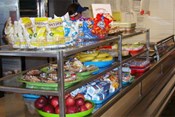In attempts to reverse U.S. childhood obesity trends, minimal, inexpensive changes in school lunchrooms yielded a nearly 20 percent increase in fruit consumption and a 25 percent increase in vegetable consumption by middle and high school students, say Cornell researchers in the Journal of Pediatrics.
"With school lunches, it's not nutrition until it's eaten," says Andrew S. Hanks, lead author, postdoctoral researcher at the Cornell Center for Behavioral Economics in Child Nutrition Programs (BEN Center). The research, "Smarter Lunchrooms Can Address New School Lunchroom Guidelines and Childhood Obesity," available online now, will be published in the April issue of the Journal of Pediatrics (162:4). Its co-authors are David R. Just, Cornell associate professor of behavioral economics, and Brian Wansink, Cornell's John S. Dyson Professor of Marketing; both are co-directors of the BEN Center.
To evaluate the effects of small interventions in two junior-senior high school (grades 7-12) cafeterias in western New York, changes were implemented in the lunchrooms to improve the convenience, attractiveness and appeal of fruits and vegetables.
Dubbed a "smarter lunchroom makeover," the process took no more than three hours and less than $50. The cafeteria took on a new complexion, as fresh fruit was placed next to the cash register in attractive bowls or tiered stands. And to make fruits and vegetable selection seem standard, lunchroom staff were trained to prompt the teens with verbal cues, such as "Would you like to try an apple today?"
Using tray waste measures, the researchers recorded what was left on trays after lunch, both before and after the intervention. After the smarter lunchroom makeover, students were 13 percent more likely to take fruits and 23 percent more likely to take vegetables.
But increasing selection is only half the battle. Actual fruit consumption increased by 18 percent and vegetable consumption by 25 percent; the students were also more likely to eat the whole serving of fruit or vegetables (16 percent and 10 percent, respectively).
Last year, the U.S. Department of Agriculture passed regulations requiring schools to increase whole grain offerings and encourage students to take either a fruit or vegetable with their purchased lunch. These low-cost, yet effective, interventions could significantly influence healthier behaviors, potentially helping to offset childhood obesity trends, Hanks says.
Hanks believes these simple changes could also be effective in the cafeterias of other organizations, including hospitals, companies and retirement homes. "This not only preserves choice, but has the potential to lead children to develop lifelong habits of selecting and consuming healthier foods -- even when confronted with less healthy options," he says.
The research was supported by the U.S. Department of Agriculture.







